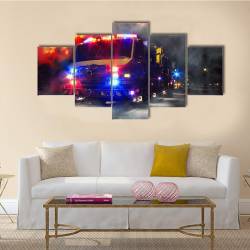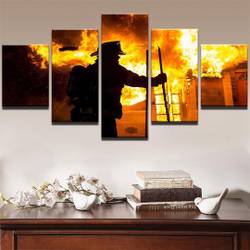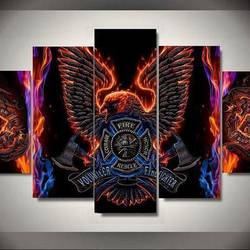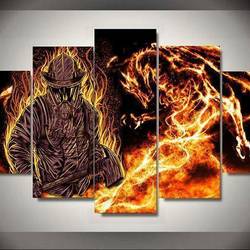No products in the cart.
The Significance of Color in Firefighter Canvas Paintings.
Firefighting is a dangerous and physically demanding profession that requires courage, strength, and determination. The lives of firefighters depend on their ability to work together as a team, respond quickly to emergencies, and protect property and lives. These attributes have long inspired artists, and firefighter canvas paintings have become a popular medium for capturing the heroism and bravery of these everyday heroes.
One of the most significant elements in firefighter canvas paintings is color. Color plays an essential role in art, conveying emotions and setting the mood for the piece. In firefighter paintings, the use of color can help capture the intensity and emotion of firefighting, highlighting the power of fire and the bravery of those who battle it.
Red is the most commonly used color in firefighter paintings, and for a good reason. Red is associated with fire and danger, and it is the color of passion, strength, and courage. In many firefighter paintings, the flames and smoke are painted in shades of red, evoking a sense of danger and urgency. The use of red can also help to create a focal point, drawing the viewer’s eye to the most critical part of the painting.
Yellow is another common color used in firefighter paintings. Yellow is associated with brightness and warmth, making it an ideal color to represent the intense heat of a fire. In many paintings, yellow is used to highlight the flames or the light cast by the fire, creating a sense of depth and movement within the painting. Yellow can also be used to represent hope, as firefighters work tirelessly to save lives and property.
Blue is not often used in firefighter paintings, but when it is, it can have a powerful effect. Blue is associated with calmness and serenity, which can be a stark contrast to the intense heat and chaos of a fire. In some paintings, blue is used to represent the calm before the storm, or the moment of peace and tranquility that exists before the chaos of a fire breaks out. Blue can also represent the dedication and focus of firefighters as they work to control and extinguish the flames.
Green is another color that is rarely used in firefighter paintings, but when it is, it can be highly symbolic. Green is associated with growth, renewal, and rebirth, making it an ideal color to represent the aftermath of a fire. In some paintings, green is used to represent the regrowth of vegetation or the rebuilding of homes and businesses after a fire has devastated the landscape.
In addition to the use of color, firefighter canvas paintings often include other symbolic elements. Helmets, axes, and hoses are often included in the paintings, as are the firefighters themselves. These elements help to create a sense of realism and authenticity in the painting, allowing the viewer to connect with the image on a deeper level.
The significance of color in firefighter canvas paintings cannot be overstated. Color plays an essential role in conveying emotion, setting the mood, and creating a focal point in the painting. Red, yellow, blue, and green are all commonly used in firefighter paintings, each representing different emotions and themes. By using color effectively, artists can capture the intensity and emotion of firefighting, highlighting the bravery and heroism of these everyday heroes.
In conclusion, firefighter canvas paintings are a powerful medium for capturing the bravery and heroism of firefighters. Color plays an essential role in these paintings, conveying emotions and setting the mood for the piece. Red, yellow, blue, and green are all commonly used in firefighter paintings, each representing different themes and emotions. By effectively using color and other symbolic elements, artists can create a sense of realism and authenticity in their paintings, allowing the viewer to connect with the image on a deeper level. The significance of color in firefighter canvas paintings cannot be overstated, and these paintings will continue to inspire and move viewers for years to come.















